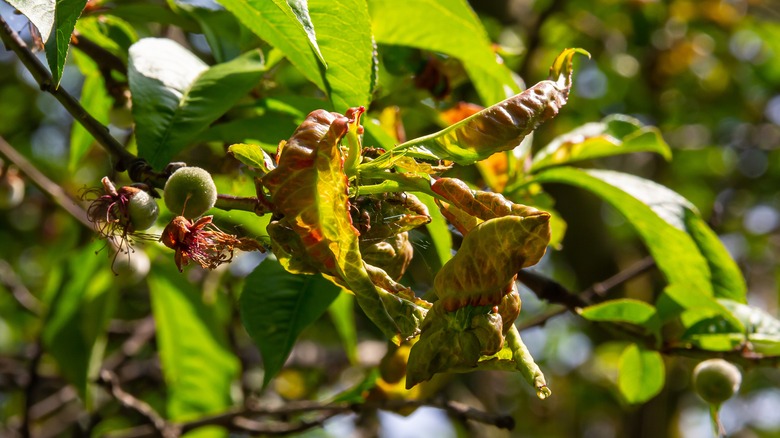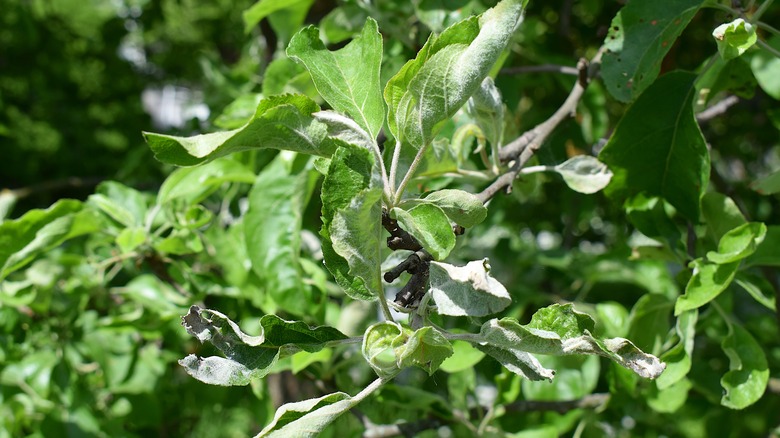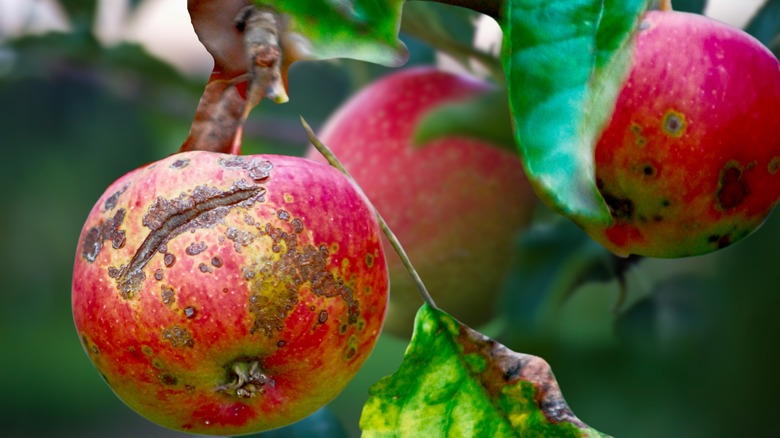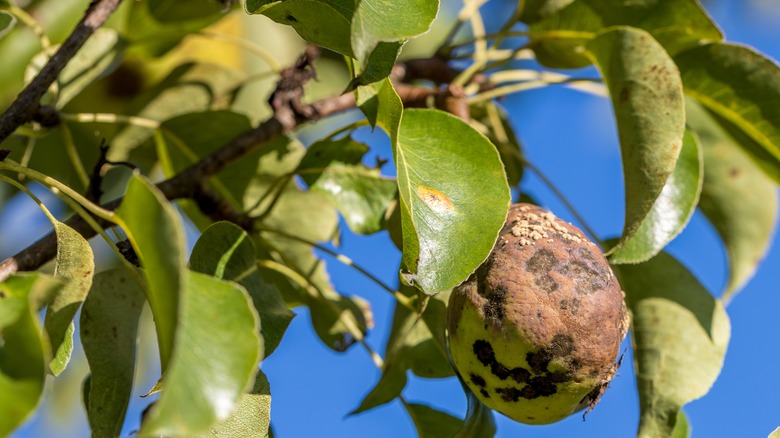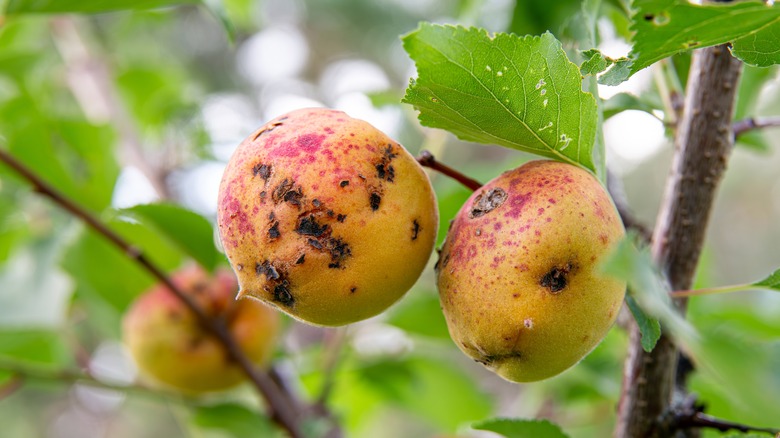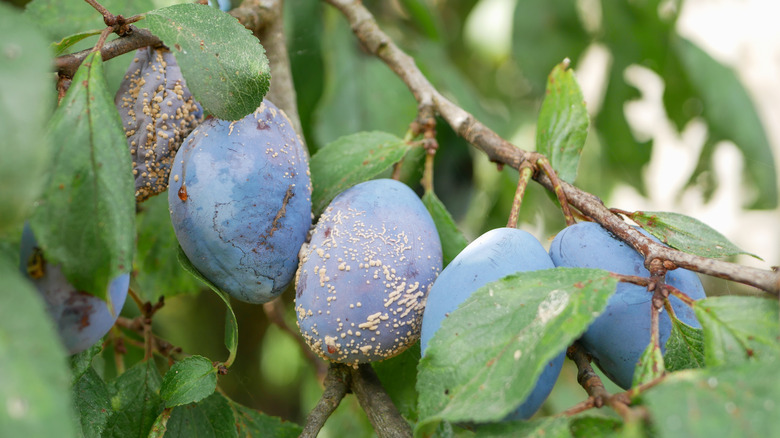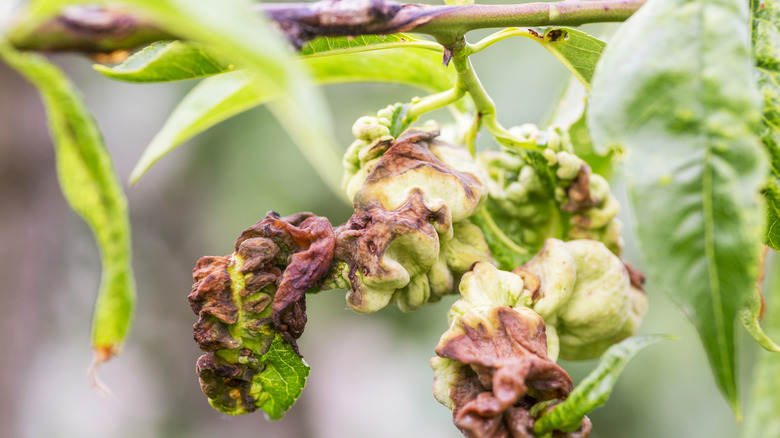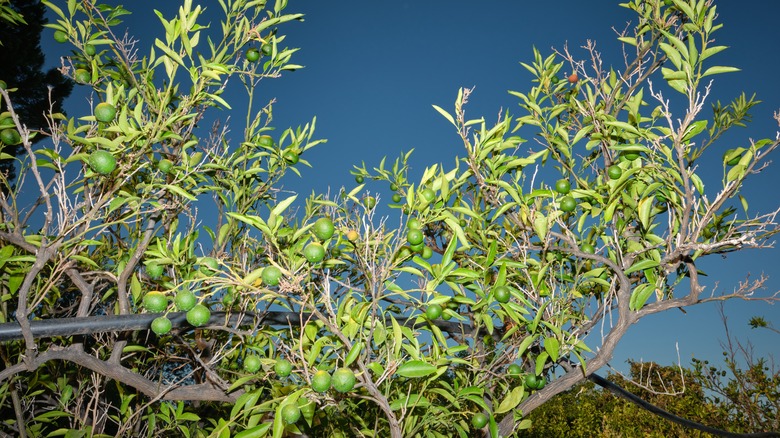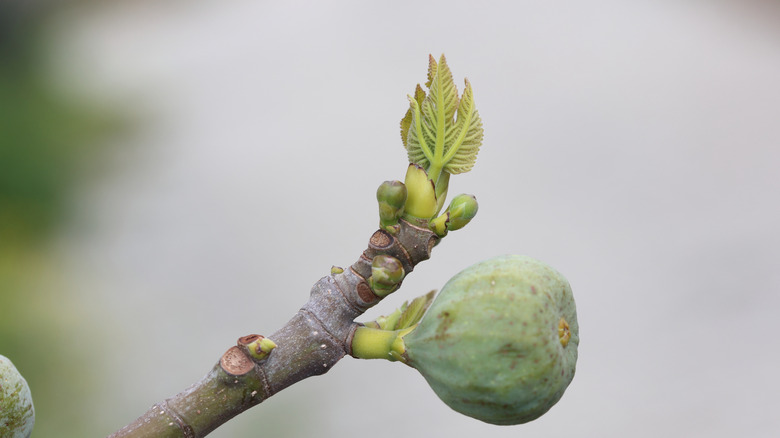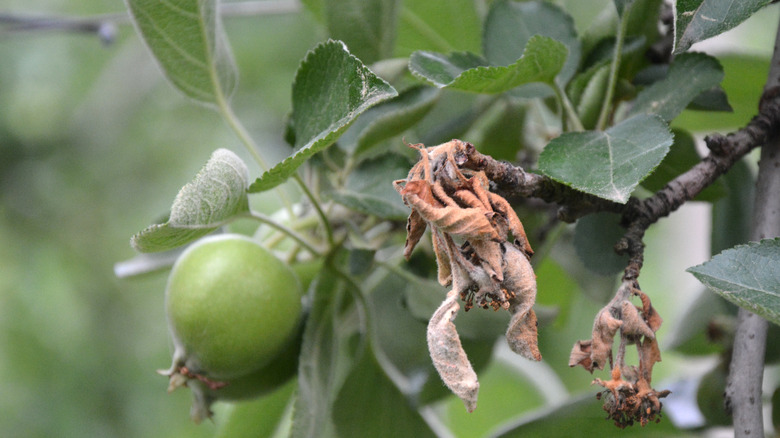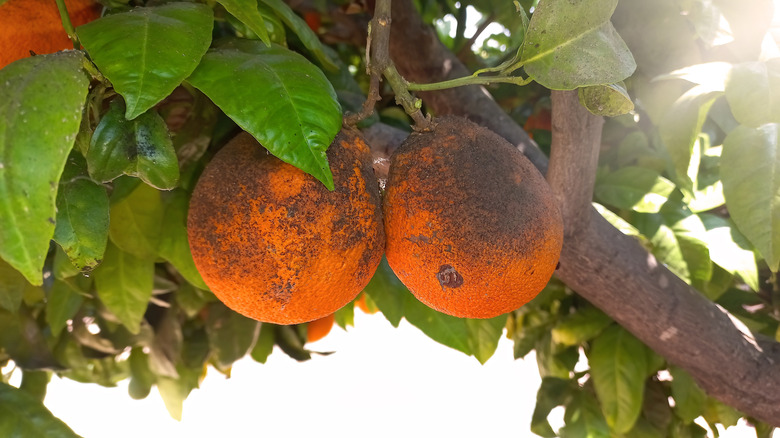10 Ways To Spot Common Fruit Tree Diseases Before They Become A Bigger Problem
Planting fruit trees can bring a bountiful harvest to your yard. You can pick your own apples, peaches, pears, oranges, figs, and more. Not only can you enjoy delicious fruit picked at the peak of ripeness, but you can also save money and avoid paying for sub-par fruit from the grocery store. However, there are many things that can stand in the way of biting into a juicy peach or a crisp apple.
One of these potential impediments is diseases, which, unfortunately, are all too common in fruit trees. And if the fruit that your tree produces turns out rotted, shriveled, or discolored, it certainly isn't going to be appealing or edible. Leaving fruit tree diseases to run their course could also seriously weaken your trees. Knowing the signs of common fruit tree diseases can help you minimize losses, protect your trees (and fruit yield), and prevent other trees in your yard or orchard from contracting the disease. Here are some things to be on the lookout that will help you spot fruit tree diseases before they become a serious problem.
Watch for white spots that can indicate powdery mildew
If you're examining your fruit trees and notice white spots on the leaves, you might be dealing with powdery mildew. As the name suggests, these white spots typically look powdery, and depending on the scale and progression of the disease, may be smaller or more widespread. Powdery mildew can cause more than just some white spots and splotches on a tree's leaves, however. As the infection progresses, the leaves may become oddly shaped or twisted. They may also turn brown or yellow, or even fall off the tree completely. Without the leaves to provide cover, the fruits on the tree will be more likely to get burnt or scorched by the sun. Powdery mildew can also directly affect the fruits growing on the tree, potentially scarring them or creating corky patches on the skin.
If you notice any signs of powdery mildew, you'll want to act quickly to prevent the disease from progressing and spreading to more areas of the tree. Pruning can help control powdery mildew. If the infection is still small and more contained, you can cut away those sections of the plant. For more widespread infections, wait until the dormant season to cut off buds that are infected. You can also use an overhead sprinkler system to rinse off the powdery mildew spores — but just be sure to avoid doing so too late in the day, as it can leave the trees more susceptible to other diseases.
Pesticides may also be helpful in preventing or controlling powdery mildew. Neem oil and other horticultural oils can be applied to the trees (as long as the temperatures are below 90 degrees Fahrenheit) and may be helpful in controlling mild infections. After clearing up an infection, sulfur products can be effective in preventing reoccurrence of powdery mildew.
Yellow spots on the leaves could be a sign of apple scab
Yellow spots on the leaves of your apple tree can be indicative of apple scab disease. If the disease is left untreated, however, these yellow spots will darken, changing into an olive color. The spots will also be visible on the apple fruits themselves. With even more severely diseased trees, the olive-colored spots won't be contained to just the leaves; they may also spread to the stems of the fruit. Other signs of apple scab include twisting leaves, leaves that pucker up, or even yellowing or falling leaves. As the apples on an infected tree grow, they are likely to become cracked, misshapen, or covered with brown, rough spots.
Apple scab is caused by a fungus, Venturia inaequalis. As you can imagine, it can be quite disastrous, leaving the fruit from the tree practically inedible. If you notice signs of apple scab, there are a few things you can try to save your tree. As the leaves drop from the tree, remove them from the ground below it and either destroy or compost them to limit the spread of the fungus. Because the fungus overwinters and then shoots spores back into the air in the spring, removing the dropped leaves can help prevent future infections. If you have multiple trees in your garden, you may also want to apply zinc or a source of nitrogen directly to the leaves in the early fall to help them drop more quickly so you can effectively remove them from the area.
You can also consider spraying your fruit trees with neem oil to avoid the disease. In rainy weather, where the leaves will stay damp for at least 9 hours, you may also need to use a fungicide to control the disease. Following the product directions, these should be applied periodically between the time when the blossoms begin emerging to a full month after all of the petals have dropped.
Pear trees with yellow spots on their leaves and shoots may have pear scab
When you're growing and caring for a pear tree, spotting signs of pear scab can be a real downer. While the signs of pear scab are similar to those of apple scab — including yellow or olive-colored spots on the leaves — the two diseases are not caused by the same fungus. While apple scab is caused by Venturia inaequalis, pear scab is caused by Venturia pirina. There are also a few differences you may notice in the way the infection presents itself. With pear scab, the spotting is often more scattered and may also affect the shoots, in addition to the leaves themselves.
Many of the control methods for apple and pear scab are also very similar. Mowing or removing the leaves and applying targeted fungicides before a period of rain can be effective. However, while you can apply zinc to the leaves of an apple tree to help them fall more quickly, it should not be used on pear trees, as it is phytotoxic for pears. Instead, stick with nitrogen sources for this, such as fertilizer-grade urea.
Small green spots on peaches, nectarines, plums, or apricots or yellow spots on the underside of leaves likely indicate scab
Apple and pear trees aren't the only fruit trees that can become infected with scab. Stone fruit trees, such as those bearing peaches, plums, apricots, or nectarines, can also develop this disease. Cladosporium carpophilum is the fungus that is responsible for causing scab in stone fruit trees. Signs of scab include the presence of dark spots on the skin of the fruits and lesions on the twigs. You're most likely to notice the signs on the fruits first (potentially when they have reached half of their expected size), as the lesions on the twigs or leaves tend to blend in more, particularly during the earlier stages.
Scab should only be a severe problem for stone fruit trees that remain overly wet during the spring or summer, after their petals have fallen. For this reason, trees that are in the shade or other areas with poor air circulation are more likely to be impacted than those that are in an area where they'll be able to dry off more fully. There are a few things you can do to prevent a scab infection from becoming more serious. Start by cutting off any twigs with signs of scab before blossoms appear in the early spring. If your stone fruit trees are being crowded by other garden plants, consider pruning back any branches from larger, overhanging trees, and thinning out shrubs that might be decreasing airflow in the area, creating a stagnant environment. If you have a large orchard, you may also need to consider applying a fungicide to keep the disease from spreading.
Generally, peach scab infections are not too serious a problem. While the fruits don't look that appetizing, once the skin is removed, the interior flesh is typically edible, juicy, and as delicious as it would be otherwise. You can pick the fruits from the trees and peel them before eating, canning, or finding other ways to use them.
Stone fruit trees with brown and withering blossoms or brown splotches over the tree or fruits likely have brown rot
Catching brown rot on stone fruit trees early is important if you want to prevent the infection from impacting more of the fruit or even spreading to other nearby fruit trees. You may first notice brown rot on the blossoms of the tree. They can wither or turn brown, and may remain attached to the twigs for a longer period of time before dropping to the ground. The spores of the Monolinia fructicol or Monolinia laxa, the fungi that cause the disease, spread to the tree blossoms on windy or rainy days. If the flowers remain wet for a prolonged period of time (between 3 and 6 hours, depending on the temperature), the infection can begin.
Once the disease starts, it can spread to the stems, tree bark, and hanging fruit. The fully ripened fruits on the trees are more likely to be infected than those that are still developing, and they may have some grayish or tannish spores on their skin. If the disease has already progressed to the fruit on the tree, it is much more likely to continue spreading to other portions of the tree, or even other stone fruit trees that are close by.
To control brown rot, cut off any shriveled fruits from the trees before the buds break in the early spring. You will also want to remove any fallen leaves and fruit from the base of the tree. Closely monitor your trees and pick fruits as soon as they have ripened. If any fruit are infected, they should be removed promptly and either buried or composted. Be sure to prune infected branches or twigs in February and March of each year to limit the spread of the disease. If the measures above aren't sufficient, you can also try applying fungicides to control the blossom blight, and then again a few weeks before picking the fruits. Myclobutanil and Propiconazole are sometimes recommended, as well as sulfur-based fungicides.
Peach or nectarine trees with reddening and puckering leaves may be suffering from peach leaf curl
As spring is gearing up and you're congratulating yourself on managing to successfully grow a peach tree from seed or deciding to plant a young nectarine – you may become concerned if you notice that the new leaves on your tree aren't growing properly. About two weeks after the leaves have started shooting, they will have odd-looking, thick red spots covering them, if the tree is infected with peach curl. These infected leaves will eventually become yellow and fall from the trees.
The good news is that peach curl is far from the worst disease that your fruit trees could be infected with. In many cases, new leaves will grow in place of the diseased ones that dropped off (unless there is too much rain and the trees remain wet for a prolonged period, allowing the disease to spread to these newly emerging leaves). Fruit yield in the year of the infection will also be negatively impacted, but the trees should remain overall healthy and ready to produce new fruit the following year. Once the tree goes dormant, apply a mixture of a copper ammonium fungicide with some added horticulture oil to the tree. Aim for a ratio of just 1% oil and 99% fungicide, and spray the solution towards the end of November and again in early February.
Older citrus trees with yellow leaves or pitting under the bark may have tristeza disease
There are some common diseases you should be aware of if you are growing lemons, oranges, or other citrus fruits. One of these is tristeza disease. Trees affected by this disease tend to be older. They typically have pitting beneath their bark and yellow leaves, possibly with mostly clear veins.
This disease most commonly occurs in trees where a sweet orange scion was grafted with a sour orange rootstock. Unfortunately, once a tree is infected, the disease cannot be reversed or eradicated. The tree may suffer from rapid decline and die. However, not all trees will die immediately, and some may even continue to put forth fruit, though the amount they produce may be lower than previous years. While you can't reverse tristeza disease, you can take steps to prevent it when planting new fruit trees. Be sure to choose only certified, disease-free citrus trees, and do not plant them by grafting a sweet orange scion to a sour orange rootstock (or buying a tree that has been grafted like this).
Wilting or browning leaves on a fig tree could indicate Phomopsis canker
There are things that you should know before planting a fig tree — or even after the fact if the tree is already in the ground. One of these facts is that if trees may become infected with a disease called Phomopsis canker. Some signs of infection to look for are brown or wilting leaves and newer shoots dying back. If the disease progresses, then the stems may develop cankers, which will appear sunken in and have a darker color than the rest of the stem. These cankers may discharge a sappy ooze.
Phomopsis canker is most likely to affect fig trees that are already stressed or experiencing other growing issues, such as those related to injury or lack of water. Pruning the diseased portions of the tree off can help control it. However, you mustn't prune if the tree is wet, as this can make it more likely for disease to be passed to other plants. Once infected sections are cut off, be sure to carefully dispose of them and avoid putting the cuttings near any other plants. After pruning, be sure to sanitize your garden equipment to make sure that you don't inadvertently spread the disease to one of the other fruit trees or plants in your yard. After pruning, you can also spray trees that were more severely impacted by the disease with a Bordeaux mixture (a combo containing copper sulfate, lime, and water) or other fungicide labeled for use on Phomopsis canker.
Fire blight on apple or pear trees can be identified by wilting and dark flowers or the presence of cankers oozing a tan liquid
Apple, pear, and other fruit trees may suffer from a bacterial disease known as fire blight. If infected with this disease, the flowers, as well as some of the shoots, will begin to wilt. Their color will also darken, changing to brown or black. Another sign of fire blight is the presence of cankers (or dead portions of bark) that ooze a tan liquid once new growth starts generating on the trees. These cankers may be on the trunk of the trees, as well as their branches or even smaller twigs. While the oozing cankers are one of the first signs to look out for, they are less easy to spot than the shriveling and dark shoots and flowers (or even fruit) that will occur a little later in the season.
While different types of trees can suffer from fire blight, pear and quince trees are among the most susceptible. The trees often become infected when their blossoms are open, as these open flowers provide an entry point for Erwinia amylovora, the bacterium that causes the disease. Some infections remain more moderate, only impacting a few flowers on a tree, while others can spread farther into the branches or trunk, killing the infected wood.
Fire blight is most likely to infect fruit trees and spread during periods of warm weather combined with moist conditions. To protect your trees against the disease, avoid irrigating them during the blooming season. Cut away and destroy any infected portions of the tree being careful not to cut too close to the canker, as this could trigger reinfection. You can also use a blossom spray on trees that have had past issues, but once the disease is present, these sprays won't get rid of any infections to the wood of the tree itself.
Dark gray splotches on the leaves can be indicative of sooty mold
All types of fruit trees can suffer from a sooty mold infection. However, you're most likely to encounter this disease if you have a pear tree. Citrus trees can also be quite susceptible. Parts of infected trees will look like they have a gray ash- or soot-like (hence, the name) covering. Unlike some other diseases that harm a tree's ability to survive, sooty mold isn't directly responsible for any damage; it simply covers parts of the plant. However, its presence can cause other threats to the trees. When the leaves are covered with the mold, sunlight isn't able to reach them as it should to help facilitate the process of photosynthesis. As you can probably guess, when photosynthesis is disrupted, the tree won't be as vigorous. When sooty mold is present, your tree's leaves may also drop earlier than they should. If any of the fruit on the tree is covered with sooty mold, clean it using a solution of warm water and a few drops of mild dish soap before eating them.
Sooty mold is caused by aphids, psylids, scales, and other sucking insects. These pests suck the sap from leaf tissue, then excrete a substance called honeydew. When sooty mold spores blow onto the honeydew, infection is able to develop. To minimize sooty mold, take measures to prevent the sap-sucking insects from becoming a problem — with fewer of them present to suck the sap from the leaves, there will be less honeydew covering the tree where sooty mold can develop. Horticultural oils are often recommended for controlling these populations. You can also try an insecticide that is designated for use on sucking insects, but be aware that options like neonicotinoid insecticides can harm pollinators.
